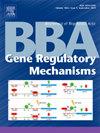The Catsper3 promoter activity is regulated by the cAMP-Response Element Modulator tau (CREMτ) and the cAMP-Response Element Binding protein 1A (CREBA) transcription factors
IF 3.1
3区 生物学
Q3 BIOCHEMISTRY & MOLECULAR BIOLOGY
Biochimica et Biophysica Acta-Gene Regulatory Mechanisms
Pub Date : 2025-08-25
DOI:10.1016/j.bbagrm.2025.195114
引用次数: 0
Abstract
Catsper3 has been shown to be essential for the proper functioning of CatSper calcium channel, sperm hyperactivation and egg fertilization. Although its function and physiological relevance to male fertility have been characterized, nothing is known about its regulation at the transcriptional level. Here, we identified the murine Catsper3 promoter and evaluated the role of CREBA and CREMτ transcription factors (TF) on its regulation. Cloning of a predicted Catsper3 promoter region and further deletion analysis indicates that Catsper3 core promoter is located at −157 to +152 relative to the transcription start site (TSS). Mutation of a TATA box and a Downstream Promoter Element (DPE) did not alter the promoter activity, indicating that this promoter is TATA and DPE independent. Exogenous expression of CREBA and CREMτ increase the Catsper3 promoter activity in the presence of the +268 to +439 region, where two CRE sites were predicted, and mutation of both CRE sites prevents the transactivation by both TFs, suggesting that CREMτ and CREBA may use these sites to promote Catsper3 transcription. Finally, binding of CREBA and CREMτ to both CRE sites was confirmed in vitro by EMSA and ChIP-qPCR assays demonstrated an enrichment of CREBA and CREMτ at the Catsper3 promoter in vivo in the testis but not in liver, indicating its tissue-specific binding. Altogether, these results strongly suggest that Catsper3 gene has a TATA-less, DPE independent promoter encompassed by −157 to +152 region around TSS and that Catsper3 gene expression is directly regulated through two CRE sites by CREBA and CREMτ.

Catsper3启动子活性受cAMP-Response Element Modulator tau (CREMτ)和cAMP-Response Element Binding protein 1A (CREBA)转录因子调控
Catsper3已被证明对Catsper3钙通道的正常运作、精子过度激活和卵子受精至关重要。虽然其功能和与男性生育能力的生理相关性已被表征,但其在转录水平上的调控尚不清楚。在此,我们鉴定了小鼠Catsper3启动子,并评估了CREBA和CREMτ转录因子(TF)在其调控中的作用。克隆预测的Catsper3启动子区域和进一步的缺失分析表明,相对于转录起始位点(TSS), Catsper3核心启动子位于- 157至+152。TATA盒子和下游启动子元件(DPE)的突变没有改变启动子的活性,表明该启动子与TATA和DPE无关。CREBA和CREMτ的外源表达增加了+268至+439区域存在的Catsper3启动子活性,其中预测了两个CRE位点,两个CRE位点的突变阻止了两个tf的反激活,这表明CREMτ和CREBA可能利用这些位点促进Catsper3转录。最后,通过体外EMSA和ChIP-qPCR分析证实CREBA和CREMτ与两个CRE位点的结合表明,体内睾丸中Catsper3启动子处的CREBA和CREMτ富集,而肝脏中没有,表明其组织特异性结合。总之,这些结果强烈表明,Catsper3基因具有一个TATA-less, DPE独立的启动子,包含在TSS周围的- 157至+152区域,并且Catsper3基因的表达由CREBA和CREMτ通过两个CRE位点直接调节。
本文章由计算机程序翻译,如有差异,请以英文原文为准。
求助全文
约1分钟内获得全文
求助全文
来源期刊
CiteScore
9.20
自引率
2.10%
发文量
63
审稿时长
44 days
期刊介绍:
BBA Gene Regulatory Mechanisms includes reports that describe novel insights into mechanisms of transcriptional, post-transcriptional and translational gene regulation. Special emphasis is placed on papers that identify epigenetic mechanisms of gene regulation, including chromatin, modification, and remodeling. This section also encompasses mechanistic studies of regulatory proteins and protein complexes; regulatory or mechanistic aspects of RNA processing; regulation of expression by small RNAs; genomic analysis of gene expression patterns; and modeling of gene regulatory pathways. Papers describing gene promoters, enhancers, silencers or other regulatory DNA regions must incorporate significant functions studies.

 求助内容:
求助内容: 应助结果提醒方式:
应助结果提醒方式:


